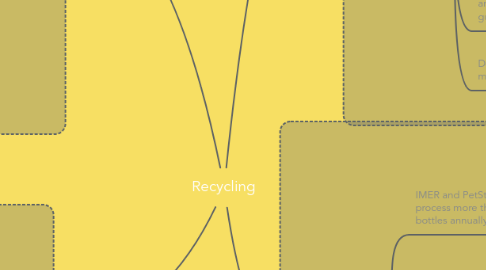
1. Sweden
1.1. 99% household waste recycled
1.1.1. Food waste
1.1.2. Combustable
1.1.3. Landfill
1.1.4. Glass
1.1.5. Plastics
1.1.6. Metals
1.1.7. Paper
1.1.8. Cartons
1.2. Electronics
1.3. Recycling stations max 300 m from residential area
1.4. 50% of household waste is burnt to produce energy
1.5. Imports garbage from other countries for a fee
1.5.1. Makes profit while receiving more fuel for energy
1.6. Government is encouraging recycling
1.6.1. Zero waste vision
2. Morocco
2.1. Ban of plastics bags in supermarket in 2016
2.1.1. Reality is that a lot of people still use it
2.1.2. Fees are given to the company which do not respect the ban
2.2. Many money invested in household waste management
2.2.1. Still only 10% of the household waste is recycled per year
2.2.2. The goal is to have a recycling rate of 30% by 2020
3. France
3.1. Less than 25% of household waste is recycled
3.1.1. “The most effective lever at the moment is undoubtedly to develop source separation for organic waste,” “This requires equipping French households with a third waste bin dedicated to this organic waste.” "Priority must be given to reducing waste at the source by cutting single-use products, using reusable packaging, and (manufacturers) extending the life of products,” Zero Waste campaign manager Laura Chatel
3.2. The government taking steps, making the rules simpler
3.2.1. France is making an effort to improve recycling rates in order to meet EU regulations, which stipulate that 100 percent of all plastics and 55 percent of all waste must be recycled by 2025.
3.2.2. A French law passed in March 2016 now says all French businesses, offices and administration must recycle waste.
3.2.3. President Emmanuel Macron's goal of reaching 100 percent plastic recycling by 2025
3.2.3.1. From 2019, items without recycled packaging could cost up to 10 percent more, while products with recycled plastic packaging could cost up to 10 percent less
3.2.3.2. A deposit-refund scheme for plastic bottles
3.2.3.3. Taxes on landfill trash will increase, while taxes for recycling will go down
3.2.3.4. Standardization of the color of recycling bins across the country.
3.3. 25th out of 30 European states when it comes to recycling, according to AFP.
3.4. Outside of Paris, some people are frustrated by the lack of availability of recycling bins and the haphazard nature of local recycling guidelines.
3.5. Depending on the municipality, recycling might be easier or harder
3.5.1. Some municipalities offer informal lists yearly of the do's and dont's of recycling, and provide citizens with proper ways to recycle
4. Mexico
4.1. IMER and PetStar have the capacity to process more than 85 thousand tons of PET bottles annually.
4.1.1. Another recycling corporations
4.1.1.1. PLASTINOR
4.1.1.2. AVELOP
4.1.1.3. SOLUPLASTIC
4.1.1.4. MORPHOPLAST
4.2. In the national territory, 28% of garbage is recycled, 14% of cardboard, 6% of glass, as well as 4% of plastic.
4.2.1. NGOs
4.2.1.1. ECOCE
4.2.1.1.1. Civil environmental association created and sponsored by the consumer products industry.
4.2.1.2. CICLOPLAST
4.2.1.2.1. Cicloplast is a non-profit society, committed to the Environment, in the promotion of the recycling of plastics at the end of its useful life, in any of its applications: packaging, agriculture, automobile, construction, etc.

